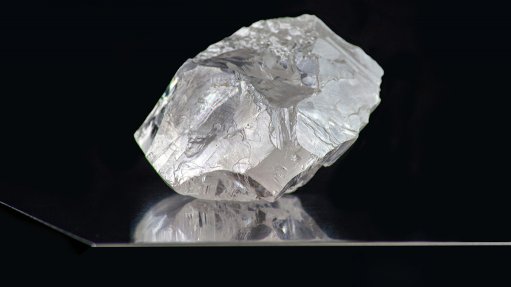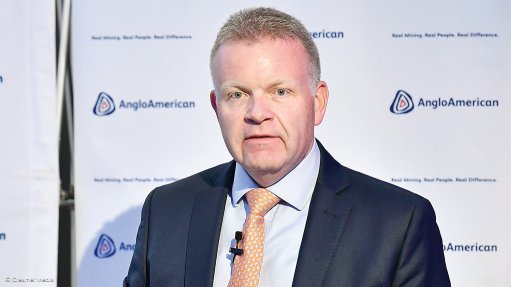Supply, demand fundamentals remain challenging – Kumba Iron Ore

Outgoing Kumba Iron Ore CEO Norman Mbazima outlines the current state of the company to Mining Weekly Online’s Martin Creamer. Photographs: Duane Daws. Video and Video Editing: Nicholas Boyd.
While iron-ore prices seem to have stabilised, supply and demand fundamentals remain challenging, outgoing Kumba Iron Ore CEO Norman Mbazima said last week.
Speaking at the Anglo American group company’s presentation of interim results for the six months to June 30, Mbazima said that the global supply of seaborne iron-ore continued to grow as a result of the ongoing ramp-up of new mine projects.
Mbazima, who will hand over the CEO reins to Themba Mkhwanazi on September 1, following his decision to step down after four years to focus on his role as deputy chairperson of Anglo American South Africa, said seaborne suppliers from Australia and Brazil continued to increase output.
Overall, seaborne iron-ore supply increased by 5%, compared with the first half of last year, and would grow by another 4% this year and rise further in 2017.
Supply from India had increased, owing to the lifting of export restrictions, and supply from the rest of the world was also up.
Despite the closure of the Samarco iron-ore mine, in Brazil, as a result of a slimes dam failure, which killed 19 people in Brazil’s worst environmental disaster, seaborne supply from Brazil rose 7%, while Australian exports rose by 4%.
In contrast, Kumba’s own production in the half-year was cut by 21% to 17.8-million tonnes to avoid placing too much iron-ore into an oversupplied market.
The deliberate oversupply of iron-ore by major producers as a way of crushing competitors has come under severe attack in Australia, where BHP Billiton and Rio Tinto have been tongue-lashed for decimating the iron-ore price to the detriment of the country’s economy.
Cliffs Natural Resources CE Laurenco Goncalves pulled no punches at the Global Iron Ore Conference, in Perth, when he outlined how $290-billion had been wiped off the market capitalisations of BHP Billiton and Rio Tinto to move Australia from a 59% market share in 2014 to 64% last year, with Brazil, through Vale, moving from 18% to 20%. “When you have 59% market share, what the hell do you need more market share for? And then you go to 64% and destroy $290-billion to do that. And you guys think that’s okay?” Goncalves chided.
But the criticism and calls for a Senate inquiry have not stopped supply increases, with even more on the way from Australia’s Roy Hill project and Brazil’s S11D and Minas Rio projects.
“This will need to be absorbed by a steel market that is contracting,” said Mbazima, who added that global iron-ore-using crude steel production fell 2.5% in the period, with continuing decline in Japan, Korea and Europe.
The export sales of Kumba, which has had to lay off 1 500 employees and 900 contractors, declined to 18.1-million tonnes.
Both the iron-ore price and the lump premium came down significantly, compared with the first half of last year, the company achieving a cash breakeven price of $34/t in a market currently fetching $52/t.
Kumba Iron Ore marketing head Dr Timo Smit said the company had managed to renegotiate its prices in China, Japan, Korea and Europe, which was having a positive impact.
Smit said financial instruments had been used since October to align pricing to the price of the day for fines but not yet lump ore.
“We’ve ramped that up quite nicely. We’re now doing about a million tonnes a month. It is purely to manage prices and to make sure we get the price of the day. “Generally, we’ve seen a small positive price uplift from using these instruments,” he said at the results presentation, which was attended by Mining Weekly.
Although signs of a return of price weakness were not yet apparent, Smit expressed the conviction that price weakness would return as a result of the ramping up of new iron-ore projects in general and the inclusion of Vale’s S11D project in particular.
“There’s an awful lot of additional supply coming in. Combined, these projects are more than 100-million tonnes and it’s coming into a market which will have difficulty absorbing that,” Smit said.
Despite the tough environment, Kumba managed to report 20% higher headline interim earnings of R3-billion in a financial performance supported by strong cash generation.
“Kumba is now cash positive, has good financial flexibility and is more resilient and better positioned to cope with the lower prices,” Mbazima told an early morning media conference in which Mining Weekly participated.
Upped productivity is providing confidence that the full-year production guidance of 12-million tonnes for Kolomela and 27-million tonnes for Sishen will be attained.
Increased productivity at Sishen has been achieved through the use of the “right equipment and the right people in the right places”, Mbazima commented in response to Mining Weekly.
Benchmarking the direct operating hours of trucks with mines around the world pointed to the need to attain 18 hours a day of direct operating hours.
“In one month, we were able to push from 11 hours a day to 15 hours a day. So you can see that productivity is beginning to approach the world benchmark.”
On the prospect of more retrenchments, Mbazima said: “We’re finished with the people issues for the moment and the concentration now is on driving actual efficiency rather than reducing staff.”
He said that a study on low-grade beneficiation plants pointed to low capital requirements and “very attractive” returns.
The progressing modular beneficiation plant at Kolomela will be commissioned in 2017 to contribute 0.7-million tonnes to the 13-million-tonne production target.
Waste guidance remains at up to 48-million tonnes in 2016, and up to 55-million tonnes from 2017 to 2020.
Estimated 2016 capital expenditure is R120-million, with total project capital estimated at R420-million.
Comments
Press Office
Announcements
What's On
Subscribe to improve your user experience...
Option 1 (equivalent of R125 a month):
Receive a weekly copy of Creamer Media's Engineering News & Mining Weekly magazine
(print copy for those in South Africa and e-magazine for those outside of South Africa)
Receive daily email newsletters
Access to full search results
Access archive of magazine back copies
Access to Projects in Progress
Access to ONE Research Report of your choice in PDF format
Option 2 (equivalent of R375 a month):
All benefits from Option 1
PLUS
Access to Creamer Media's Research Channel Africa for ALL Research Reports, in PDF format, on various industrial and mining sectors
including Electricity; Water; Energy Transition; Hydrogen; Roads, Rail and Ports; Coal; Gold; Platinum; Battery Metals; etc.
Already a subscriber?
Forgotten your password?
Receive weekly copy of Creamer Media's Engineering News & Mining Weekly magazine (print copy for those in South Africa and e-magazine for those outside of South Africa)
➕
Recieve daily email newsletters
➕
Access to full search results
➕
Access archive of magazine back copies
➕
Access to Projects in Progress
➕
Access to ONE Research Report of your choice in PDF format
RESEARCH CHANNEL AFRICA
R4500 (equivalent of R375 a month)
SUBSCRIBEAll benefits from Option 1
➕
Access to Creamer Media's Research Channel Africa for ALL Research Reports on various industrial and mining sectors, in PDF format, including on:
Electricity
➕
Water
➕
Energy Transition
➕
Hydrogen
➕
Roads, Rail and Ports
➕
Coal
➕
Gold
➕
Platinum
➕
Battery Metals
➕
etc.
Receive all benefits from Option 1 or Option 2 delivered to numerous people at your company
➕
Multiple User names and Passwords for simultaneous log-ins
➕
Intranet integration access to all in your organisation



















